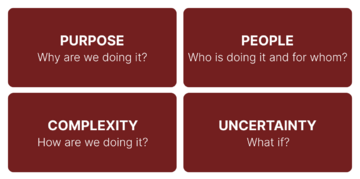The Role of Program Management in an Organisational Change
Developed by Sebbe Sidenius Bull
Revised by Cirkeline Bräuner
ADD SOURCES
In today's rapidly changing society, organisations are going through changes all the time. This causes, that organisations must be able to adapt to new market conditions, changing customer demands and emerging technology. To remain competitive in a continuously evolving business environment, organisations go through changes such as process optimisation, cost reduction or technology adoption. These are few examples of changes which affect the entire business, and it is therefore crucial that the change is managed in a successful way to avoid harming the business.
Organisational change is a huge alteration for any organisation and can be a dawning task if not managed properly. In the context of project management, organisational change refers to any significant alteration in an organisation that affects the way projects are planned, executed and managed. Project managers must be able to identify the potential impact of organisational changes in their projects and adapt their project management approach accordingly to ensure successful project delivery. (THIS SOUND WIERD) In this regard, program management can serve as an effective tool for managing organisational change. With its comprehensive toolbox of evaluative methods, program management offers a structured approach to assessing each potential change project. This toolbox supports change managers in providing an overview of the change project, ensuring efficient project execution, promoting project alignment, evaluating risks, mapping stakeholders and identifying potential benefits. All of these elements work together to facilitate a more effective and efficient change management process.
(UPDATE) This article provides an introduction to what change management is and how it can be related to the four core perspectives of this course; purpose, people, complexity and uncertainty. Afterwards, an introduction to program management is given. Then, the two management fields are combined into one common understand of how program management can be applied in organisational change. Lastly, the benefits and limitations of organisational changes using program management is discussed.
Contents |
Change management
WRITE INTRODUCTION
What is change?
"The act or result of something becoming different" or "The process of replacing something with something new or different" [1] are two examples of a definition of what a change is.
A change is simply a variation in the common way of doing things. It refers to any modification, alteration or transformation in something from its previous state to a new state. Changes occur everywhere and is an opportunity to make or become different through new ways of acting. Changes can be temporary or permanent, positive or negative and gradual or sudden. It can be a source of growth and development as well as a source of challenges and difficulties (SOURCE).
Changes are defined as either incremental or radical. An incremental change is a change which happens gradually over time. It involves making small adjustments of an already existing system to improve efficiency, effectiveness and performance. An example of an incremental change is making small step-by-step adjustments in an organisation's strategy. Radical change, on the other hand, is different from incremental change as it involves making a significant change such as introducing a completely new business strategy. Both types of changes can be beneficial for different purposes and choosing the right approach depends on the context [2].
What is change management?
In the section above, the definition of a change is briefly described. This leads on to the next topic, which deals with what change management is from a project management point of view. Unfortunately, there is not a single recipe for applying change management in organisations as the is no one-size-fits-all approach. The process has to be tailored to the specific needs and circumstances of the organisation.
However, the psychologist Kurt Lewin has represented a simplified way of viewing a change process [3]. As illustrated in the Figure 1, the change process is divided into three distinct stages; freeze, change and refreeze.

- Unfreeze: The first stage characterises the starting point of the change process where the organisation prepares for the change. This involves creating awareness about the need for the change, identifying current behaviours and to get people to let go of their old ways of thinking and working [5].
- Change: The second stage involves implementing the change through planning, communication and execution. The objective is to create new ways of thinking and working. During this phase, people must be trained and educated to adopt new methods and behaviours and to overcome any obstacles that may arise [3].
- Refreeze: The third stage addresses making the new change permanent. The objective is to reinforce the new behaviours, ensuring that they become a part of the organisation's culture. During this phase, the focus is on stabilising the new ways of thinking and working, and creating a sense of ownership among employees [3].
Why is organisational change a difficult task?
To better understand and visualise why organisational change is a difficult task to manage, the topic is viewed from the point of view of the four core perspectives introduced in the course; purpose, people, complexity and uncertainty [6]. The challenges related to change management within each perspective are briefly described below. In addition, the four perspectives are visualised in Figure 2, where the core of each perspective is described by a question.

- Purpose: Before even introducing a change process within an organisation, it is important to clearly define the purpose. Defining the purpose of the change clearly and communicating it to the rest of the organisation can be a challenging task. However, it ensures that the goal and objectives of the change are aligned with the organisation's strategy.
- People: It is human to make mistakes, and as change processes are driven by people, mistakes are also likely to occur. However, people are a necessity to create awareness of the need for the change in the first place. Furthermore, it is also people who are affected by the change.
- Complexity: A change process can be complex to implement successfully in an organisation. This is for instance due to the fact that the process involves difficult tasks such as important decisions, multiple stakeholder, clear communication and effective leadership.
- Uncertainty: Organisational change processes do often involve uncertainty. While the organisation may have a clear purpose of what it wants to achieve, there may be limited information, unforeseen challenges or unintended outcomes that cannot be predicted in advance.
Program management
Changes are often managed less effectively than they might be as those responsible for managing the change fails to attend some of the critical factors of the process as presented above. Not managing the change process in an effective and successful way can impact the entire organisation negatively and ultimately result in the organisation not surviving. These factors are often managed by the program manager in the given organisation which leads to an introduction of the next topic about program management.
What is program management?
Program management is a discipline which involves managing a collection of related projects that are designed to achieve a specific goal or objective. Program managers are responsible for ensuring that all projects within a program are aligned with the organisations common strategy and goals [7].
Program management has taken its position in organisations as a successful method for managing complex and uncertain changes.
How does program management fit into an organisation?
Program management plays an important role in the overall functioning of an organisation, especially when it comes to implementing change processes. This causes, that program management provides a structured approach to manage change initiatives.
Program framework: https://www.projectsmart.com/articles/framework-for-programme-management.php
Application of program management in organisational change
Change management and program management do often work in parallel with each other in an organisation.
As described above, a program manager is responsible for managing a group of related projects. By managing these project as a group, a program manager must ensure that the changes being implemented are aligned with the rest of the projects as well as with the organisation's common strategy.
https://dti.delaware.gov/about-dti/offices/office-chief-policy-communications/change-management/
Benefits and limitations
Annotated bibliography
References
- ↑ https://www.oxfordlearnersdictionaries.com/definition/english/change_2 Definition of change, last visited 02-03-2023
- ↑ Hodges, J (2016), Managing and Leading People through Organisational Change, Kogan Page, England
- ↑ 3.0 3.1 3.2 Hayes, J (2010). The Theory and Practice of Change Management, PALGRAVE MACMALLIN, New York
- ↑ https://expertprogrammanagement.com/2021/09/unfreeze-change-refreeze/ Unfreeze, change, refreeze, last visited 02-03-2023
- ↑ Kotter J. P (1996). Leading Change, Harvard Business School Press, Boston
- ↑ 6.0 6.1 https://www.doing-projects.org/perspectives Project management perspectives, last visited 02-03-2023
- ↑ https://www.pmi.org/learning/featured-topics/program Definition of program managment, last visited 02-03-2023